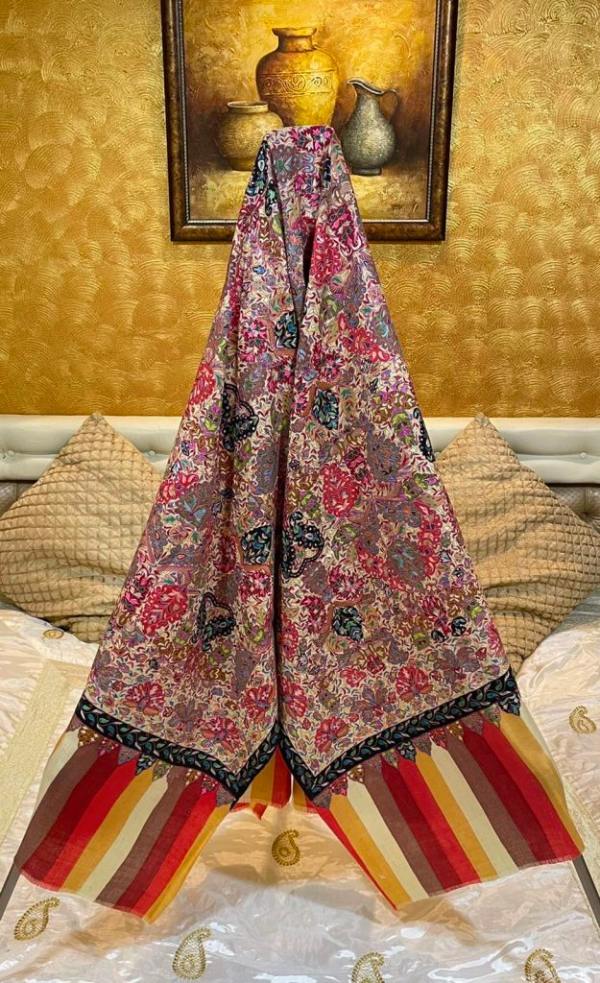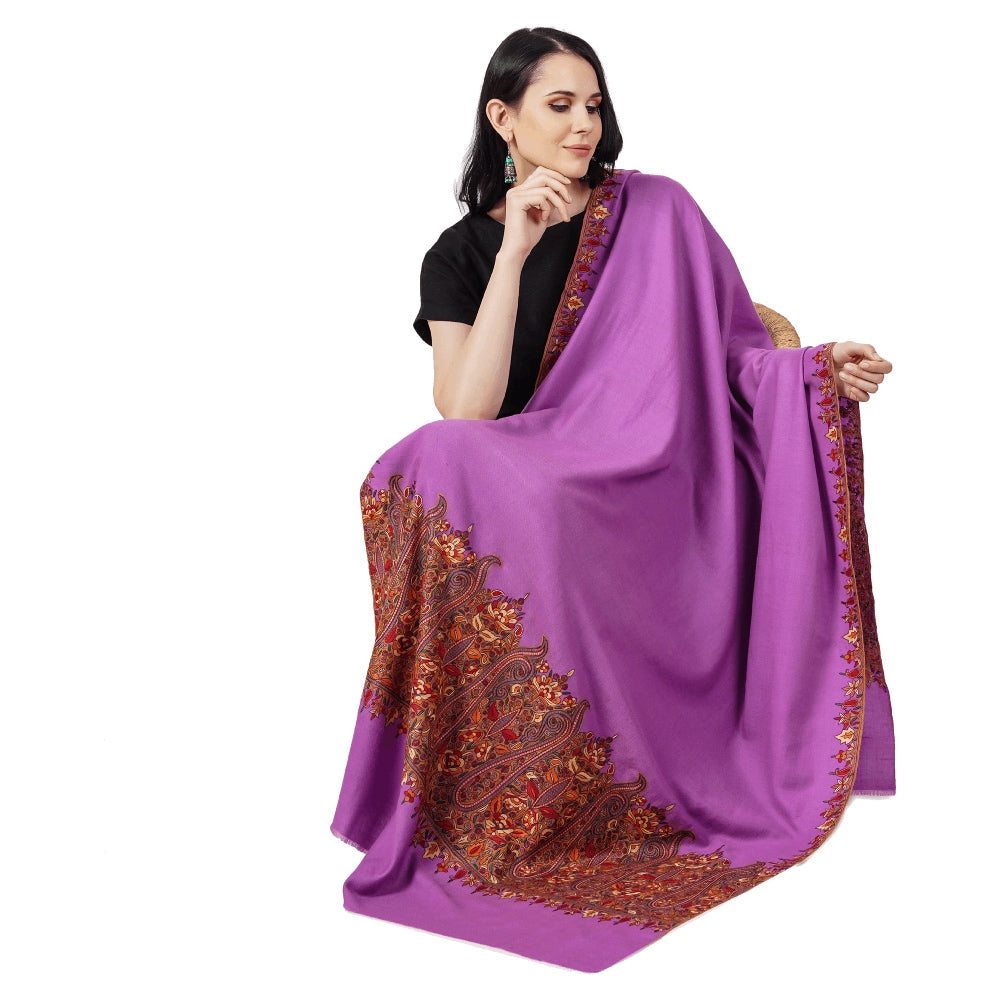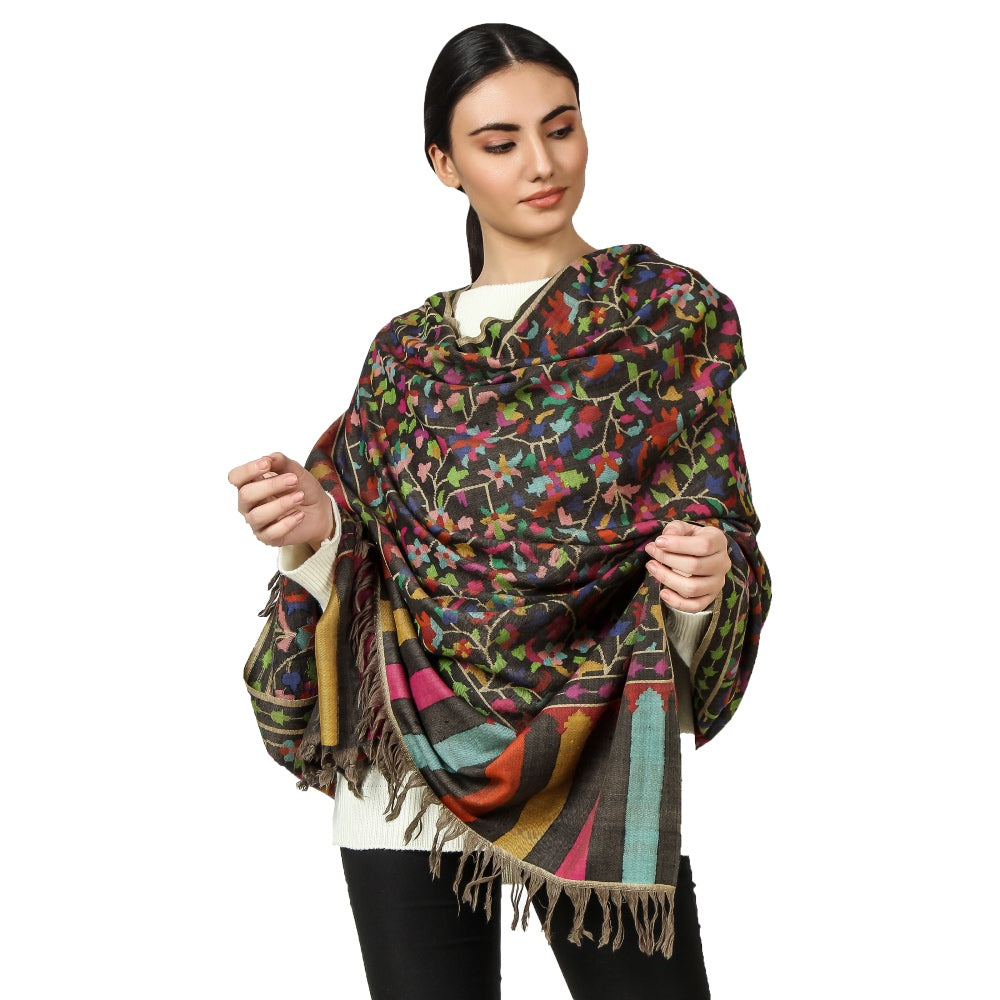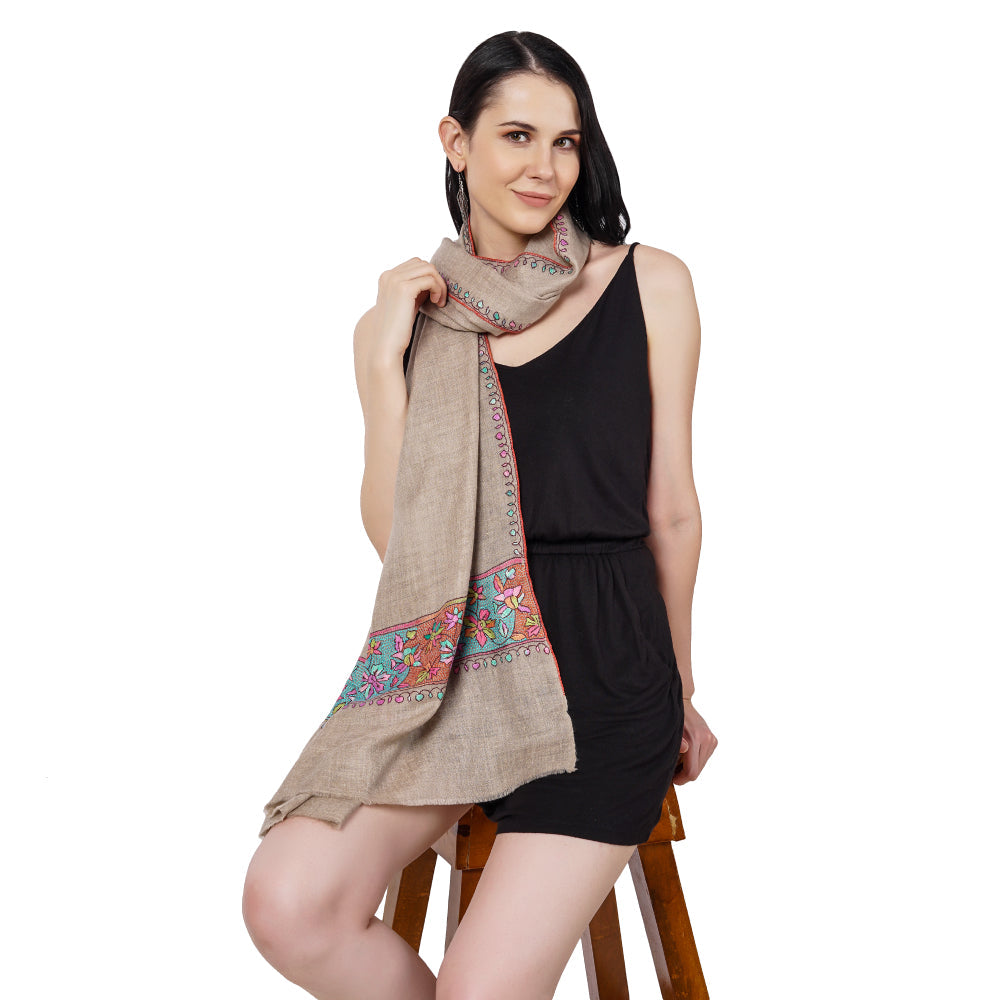
Why Pashmina Shawls are Famous in India?
Share
Pashmina shawls are exquisite and luxurious garments known for their exceptional softness, warmth, and fine craftsmanship. Originating from the Kashmir region in India, Pashmina shawls have gained worldwide recognition for their unparalleled quality and beauty. These shawls are made from the fine undercoat fibers of the Pashmina goat, a breed native to the Himalayan regions. Pashmina shawls are renowned for their lightweight feel and the ability to provide warmth in even the coldest of climates. They have become a symbol of elegance and grace, adorning the shoulders of both men and women across the globe.

Pashmina shawls hold a special place in Indian culture and have been cherished for centuries. In India, Pashmina shawls are highly regarded for their cultural significance, as they have been worn by royalty, nobility, and esteemed personalities throughout history. These shawls are associated with opulence, sophistication, and a sense of heritage. Pashmina shawls are an integral part of traditional Indian attire, often worn during weddings, festive celebrations, and other auspicious occasions. Their popularity extends beyond formal events, as they are also cherished as everyday accessories, adding a touch of elegance to any ensemble. The rich heritage and timeless appeal of Pashmina shawls have made them a beloved fashion statement in India and a symbol of pride for the country's artisanal craftsmanship.
Historical Significance of Pashmina Shawls
A. Origins of Pashmina shawls in the Kashmir region:
The origins of Pashmina shawls can be traced back to the picturesque valleys of Kashmir in the northernmost region of India. Kashmir has long been renowned for its breathtaking natural beauty and rich cultural heritage. It is in this region that the art of crafting Pashmina shawls flourished. The Himalayan climate and the availability of the Pashmina goat, whose fine undercoat is used to create these shawls, contributed to the emergence of Kashmir as a hub for Pashmina production.
B. Pashmina's association with Indian royalty and nobility:
Pashmina shawls have a deep-rooted association with Indian royalty and nobility. From ancient times, Pashmina shawls were considered a symbol of prestige and were treasured by kings, queens, and members of the royal court. The elegance, softness, and warmth provided by Pashmina made it the preferred choice for the elite class. The shawls were not only worn as a fashion statement but also gifted as a gesture of honor and respect. The association of Pashmina shawls with the Indian aristocracy further elevated their status and solidified their position as a symbol of luxury and refinement.
C. Influence of Mughal emperors on the popularity of Pashmina:
The Mughal emperors played a significant role in popularizing Pashmina shawls during their reign in India. The Mughals, known for their love of art, culture, and exquisite craftsmanship, were captivated by the beauty and elegance of Pashmina shawls. They recognized the unparalleled quality and craftsmanship of these shawls and became avid patrons of Pashmina artisans. The Mughal emperors, such as Akbar, Jahangir, and Shah Jahan, not only wore Pashmina shawls themselves but also promoted their use among the nobility and in the royal courts. This patronage from the Mughal rulers further enhanced the prestige and popularity of Pashmina shawls in India and beyond.
The historical significance of Pashmina shawls in the Kashmir region, their association with Indian royalty and nobility, and the influence of Mughal emperors collectively contribute to the revered status of Pashmina shawls in India's cultural heritage. These factors have helped shape the enduring legacy of Pashmina as a symbol of elegance, refinement, and artistic craftsmanship.
Also read: The legends of Kashmiri Shawls: Rich Cultural Heritage
Understanding Pashmina Shawls
A. Definition and characteristics of Pashmina:
Pashmina refers to a type of shawl or stole made from the fine wool fibers obtained from the undercoat of the Pashmina goat, scientifically known as Capra hircus. The term "Pashmina" itself translates to "soft gold" in Persian, signifying the exquisite softness and preciousness of the fabric. Pashmina is known for its exceptional warmth, lightweight feel, and delicate texture, making it highly sought after in the world of luxury textiles. These shawls are typically hand-woven using traditional techniques and are renowned for their exceptional quality and comfort.
B. Differentiating Pashmina from other types of shawls:
Pashmina shawls stand apart from other types of shawls due to their unique characteristics and the superior quality of the wool used. While there are various types of woolen shawls available, what sets Pashmina apart is its fineness and softness. Pashmina wool fibers are significantly finer and thinner than regular wool, giving the shawls a luxurious and delicate feel. This exceptional softness and warmth are the result of the harsh Himalayan climate and the adaptation of Pashmina goats to survive in those extreme conditions. Compared to synthetic or blended shawls, Pashmina shawls have a natural sheen, unmatched insulation, and a luxurious drape.
C. The art of making Pashmina shawls:
Creating Pashmina shawls is a labor-intensive and intricate process that involves skilled craftsmanship and meticulous attention to detail. The journey of a Pashmina shawl begins with the careful and ethical collection of the fine undercoat fibers from Pashmina goats during the spring molting season. These fibers are then meticulously sorted to remove any coarse hairs or impurities, ensuring only the softest and finest fibers are used. The next step involves spinning the fibers into yarn using traditional spinning wheels or tools. Hand-weaving techniques, such as the twill weave or the jacquard weave, are then employed to create the intricate patterns and designs on the loom. After weaving, the shawls undergo a process of washing, stretching, and finishing to enhance their texture and drape. Skilled artisans may also incorporate intricate embroidery or embellishments using techniques like aari work or needlework to further enhance the beauty of the shawls. The entire process of making Pashmina shawls is a testament to the dedication and craftsmanship of the artisans involved, resulting in the creation of exquisite and timeless pieces of wearable art.
Significance of Pashmina Shawls in Indian Culture
A. Pashmina as a symbol of luxury and elegance:
Pashmina shawls hold a prominent place as a symbol of luxury and elegance in Indian culture. The softness, warmth, and exquisite craftsmanship of Pashmina make it a highly desirable accessory for those seeking refined and opulent fashion choices. The inherent beauty and delicate texture of Pashmina shawls elevate any outfit, adding a touch of sophistication and allure. The intricate patterns, fine embroidery, and rich colors found in Pashmina shawls further enhance their luxurious appeal. Wearing a Pashmina shawl is not merely about donning a garment but embracing an embodiment of grace and refined taste.
B. Pashmina shawls in traditional Indian attire:
Pashmina shawls are an integral part of traditional Indian attire. They are often paired with traditional garments such as sarees, salwar kameez, lehengas, or sherwanis, enhancing the overall look and adding a regal touch. Pashmina shawls beautifully complement the vibrant colors and intricate designs of Indian attire, creating a harmonious and captivating ensemble. They are worn draped over the shoulders, elegantly enhancing the grace and poise of the wearer. Pashmina shawls not only provide warmth during colder months but also serve as a fashion statement, reflecting the wearer's cultural heritage and sense of style.
C. Pashmina's association with festivals and special occasions:
Pashmina shawls are deeply associated with festivals and special occasions in India. During weddings, religious ceremonies, and festive celebrations, Pashmina shawls are considered auspicious and are often exchanged as gifts. They hold a symbolic value, representing blessings, prosperity, and good fortune. Pashmina shawls are also favored during religious rituals and cultural performances, where they are worn by priests, performers, and participants to exude a sense of reverence and grace. These shawls have become an integral part of the cultural fabric of India, being passed down through generations as cherished heirlooms and treasured memories.
The significance of Pashmina shawls in Indian culture goes beyond their visual appeal. They embody the essence of luxury, elegance, and heritage. Whether adorning traditional attire, gracing special occasions, or being gifted as symbols of love and respect, Pashmina shawls continue to be an iconic representation of India's rich cultural heritage and a testament to the timeless allure of this exquisite textile.
The Exquisite Craftsmanship of Pashmina Shawls
A. Hand-weaving techniques used in Pashmina production:
The production of Pashmina shawls involves the skilled application of various hand-weaving techniques that have been passed down through generations. Artisans meticulously weave the Pashmina yarn using traditional looms, ensuring precision and attention to detail. One of the commonly used weaving techniques is the twill weave, which creates a diagonal pattern on the fabric, adding texture and depth to the shawl. Another technique is the jacquard weave, which allows for the creation of intricate and elaborate designs. The artisans' mastery of these hand-weaving techniques is evident in the flawless and refined finish of each Pashmina shawl.
B. Traditional motifs and designs found in Pashmina shawls:
Pashmina shawls are adorned with a rich tapestry of traditional motifs and designs that showcase the artistic heritage of India. These motifs are deeply rooted in the cultural and natural landscapes of the region. Popular motifs include paisleys, floral patterns, chinar leaves, shikargah (hunting scenes), and intricate geometric designs. Each motif carries its own symbolic meaning, reflecting aspects of nature, spirituality, or cultural narratives. These designs are carefully incorporated into the fabric during the weaving process, resulting in visually stunning and captivating Pashmina shawls that tell stories through their intricate patterns.
C. Embroidery and embellishments on Pashmina shawls:
In addition to the art of weaving, Pashmina shawls often feature exquisite embroidery and embellishments that further elevate their beauty and craftsmanship. Skilled artisans employ techniques such as aari work, which involves intricate needlework using a hook-shaped needle. This technique allows for the creation of elaborate patterns and designs, adding a three-dimensional aspect to the shawls. Other embellishments include sequins, beads, and zardozi, which involve the use of metallic threads and precious gemstones. These meticulous and intricate embroidery and embellishments enhance the overall aesthetics of Pashmina shawls, creating stunning works of wearable art.
The exquisite craftsmanship of Pashmina shawls is a testament to the skill and dedication of the artisans involved. Through their mastery of hand-weaving techniques, incorporation of traditional motifs, and intricate embroidery and embellishments, these artisans create Pashmina shawls that are not only visually captivating but also reflect the rich cultural heritage of India. The craftsmanship and attention to detail invested in each Pashmina shawl ensure that it remains a cherished piece of art, appreciated by connoisseurs of fine textiles around the world.
The Superior Quality of Pashmina Fibers
A. Exploring the unique properties of Pashmina wool:
Pashmina fibers possess exceptional qualities that set them apart from other types of wool. The fibers obtained from the undercoat of the Pashmina goat are incredibly fine and soft, measuring just 12 to 16 microns in diameter. This fine diameter results in a luxurious texture that is incredibly soft to the touch. Pashmina fibers are also known for their natural elasticity, allowing them to retain their shape and drape gracefully. Moreover, Pashmina wool has a natural ability to provide insulation, keeping the wearer warm in colder climates while still being lightweight and breathable.

B. Factors contributing to the softness and warmth of Pashmina:
The exceptional softness and warmth of Pashmina can be attributed to several factors. Firstly, the breed of the Pashmina goat itself plays a significant role. These goats have adapted to survive in the harsh Himalayan climate, and their undercoat fibers have developed a natural softness and warmth to protect them from the extreme cold. Additionally, the grazing habits of the Pashmina goats, which involve feeding on high-altitude grasses and shrubs, contribute to the fineness and quality of their wool. The rigorous selection and sorting process during Pashmina production also ensure that only the finest and softest fibers are used, enhancing the overall quality of the shawls.
C. The role of climate and altitude in Pashmina production:
The climate and altitude of the Himalayan regions where Pashmina goats are found play a crucial role in the production of Pashmina shawls. The extreme cold and harsh conditions of these high-altitude areas prompt the Pashmina goats to grow a thick undercoat, which provides insulation and protection. The sub-zero temperatures stimulate the growth of ultra-fine fibers, as the goats adapt to survive in these frigid climates. This unique climate, combined with the goats' genetic predisposition, results in the production of the finest and softest Pashmina wool. The altitude at which the goats are raised also affects the quality of the wool, as higher altitudes are known to yield even finer fibers.

The superior quality of Pashmina fibers is a result of various factors, including the fine diameter, natural softness, and insulation properties. The unique adaptation of Pashmina goats to the harsh Himalayan climate, the grazing habits, and the altitude all contribute to the exceptional quality of Pashmina wool. These factors combine to create shawls that are not only luxuriously soft and warm but also lightweight, making Pashmina an exquisite choice for those seeking the highest standard of quality in their garments.
The Artisans Behind Pashmina Shawls
A. The skilled craftsmen and weavers of Pashmina:
Pashmina shawls owe their exceptional beauty and quality to the skilled craftsmen and weavers who bring them to life. These artisans possess a deep understanding of the intricacies of Pashmina production, acquired through years of training and experience. They possess a keen eye for detail, ensuring that each thread is meticulously woven and every motif is flawlessly incorporated into the fabric. The craftsmen and weavers take immense pride in their work, as they contribute to the creation of timeless pieces that showcase the rich heritage and craftsmanship of the Kashmir region.
B. Preserving and passing down the traditional Pashmina craftsmanship:
Preserving the traditional Pashmina craftsmanship is of utmost importance to ensure the continuation of this exquisite art form. Many artisans are part of families with generations of experience in Pashmina production, and they are committed to passing down their skills and knowledge to the next generation. Apprenticeships and mentorship programs play a crucial role in this process, allowing aspiring artisans to learn from the masters and gain hands-on experience. Additionally, organizations and institutions are working to promote and support the Pashmina craft, providing training, resources, and platforms for artisans to showcase their work.
C. Challenges faced by Pashmina artisans in the modern era:
Despite the enduring appeal of Pashmina shawls, artisans face several challenges in the modern era. One of the significant challenges is the availability of skilled artisans. As younger generations are drawn to alternative professions and lifestyles, there is a risk of the traditional craftsmanship being lost. Additionally, the increasing demand for faster production and lower costs poses a challenge to maintaining the meticulous handcrafted process of Pashmina production. Industrialization and the rise of mass-produced imitations also threaten the livelihoods of Pashmina artisans. It is crucial to raise awareness about the value of authentic, handcrafted Pashmina and support fair trade practices to ensure the sustainability and livelihood of these artisans.
The artisans behind Pashmina shawls are the custodians of a centuries-old craft, and their expertise and dedication contribute to the creation of masterpieces. Preserving and passing down the traditional craftsmanship is vital for the continued existence of this art form. By supporting and valuing the work of these artisans, we can ensure that their skills are honored, their livelihoods are sustained, and the legacy of Pashmina craftsmanship endures for generations to come.
Sustainability and Ethical Considerations in Pashmina Production
A. Ensuring fair trade practices in the Pashmina industry:
In recent years, there has been a growing emphasis on ensuring fair trade practices in the Pashmina industry. This involves establishing fair wages and safe working conditions for the artisans involved in Pashmina production. Fair trade organizations work closely with producers and artisans to create equitable partnerships, promote transparency, and eliminate exploitative practices. By supporting fair trade Pashmina, consumers can contribute to the well-being and empowerment of the artisans, ensuring that they receive fair compensation for their craftsmanship.
B. Sustainable sourcing of Pashmina fibers:
Sustainable sourcing of Pashmina fibers is crucial for the long-term viability of the industry and the preservation of the environment. Efforts are being made to promote responsible grazing practices for Pashmina goats, ensuring that they are well cared for and their natural habitat is protected. Sustainable management of grazing lands and conservation programs help maintain the delicate balance between the Pashmina goat population and the fragile Himalayan ecosystem. Additionally, initiatives are being implemented to reduce the environmental impact of the dyeing and processing stages of Pashmina production, encouraging the use of eco-friendly dyes and efficient waste management practices.
C. Initiatives promoting ethical Pashmina production:
Various initiatives and organizations are working towards promoting ethical Pashmina production. These initiatives focus on educating consumers about the importance of ethical choices and the impact of their purchasing decisions. They encourage consumers to seek out certified Pashmina products that adhere to strict ethical standards. Certifications such as the Responsible Wool Standard (RWS) and the Global Organic Textile Standard (GOTS) help ensure that Pashmina products meet specific criteria for ethical sourcing, fair treatment of animals, and environmentally sustainable practices. Through these initiatives, consumers are empowered to make informed choices that support ethical and sustainable Pashmina production.
Sustainability and ethical considerations are increasingly important in the Pashmina industry. By embracing fair trade practices, promoting sustainable sourcing of fibers, and supporting initiatives for ethical Pashmina production, we can contribute to the preservation of this exquisite craft and the well-being of the artisans and the environment. Through our conscious choices as consumers, we can make a positive impact and help create a more sustainable and ethically responsible Pashmina industry.
Pashmina Shawls in Fashion and Global Influence
A. Pashmina's presence on international runways and fashion shows:
Pashmina shawls have made a significant impact on the global fashion scene, with their presence on international runways and fashion shows. Renowned fashion designers and luxury brands have recognized the allure and elegance of Pashmina, incorporating it into their collections. Pashmina shawls have been showcased in fashion capitals such as Paris, Milan, and New York, capturing the attention of fashion enthusiasts worldwide. The fine craftsmanship, luxurious texture, and exquisite designs of Pashmina shawls have established them as a symbol of sophistication and timeless elegance in the fashion industry.
B. Celebrities and influencers promoting Pashmina shawls:
The endorsement of Pashmina shawls by celebrities and influencers has contributed to their popularity and global influence. Celebrities from various fields, including Hollywood actors, musicians, and royalty, have been spotted wearing Pashmina shawls on red carpets, at events, and in their daily lives. Influencers and fashion bloggers also play a crucial role in promoting Pashmina, showcasing its versatility and styling options to their large online following. The endorsement of Pashmina by these influential figures has heightened its desirability and introduced it to new audiences, further cementing its position as a coveted fashion accessory.
C. The global demand for Pashmina products:
Pashmina shawls have witnessed a significant surge in global demand in recent years. Fashion-conscious individuals across the world are drawn to the unparalleled beauty, softness, and luxurious feel of Pashmina. Its versatility allows it to be styled in various ways, making it a staple accessory for both formal and casual occasions. Pashmina's ability to provide warmth without sacrificing style has made it a sought-after choice in colder regions. Additionally, the rising interest in sustainable and ethical fashion has contributed to the growing demand for Pashmina products, as it is recognized as a natural and artisanal alternative to mass-produced garments. As a result, Pashmina shawls have become a global fashion statement, adorning individuals from diverse cultures and backgrounds.
The presence of Pashmina shawls on international runways, the endorsement by celebrities and influencers, and the global demand for Pashmina products collectively highlight its influence in the fashion world. Pashmina's timeless elegance, exquisite craftsmanship, and association with luxury have solidified its position as a coveted accessory. As it continues to captivate the fashion industry and gain popularity worldwide, Pashmina's global influence is set to endure, celebrating the artistry and allure of this iconic textile.
Also read: Kashmiri Pashmina, Why is GI tag so important?
Caring for Pashmina Shawls
A. Cleaning and maintenance tips for Pashmina shawls:
Proper cleaning and maintenance are essential to preserve the beauty and longevity of Pashmina shawls. It is recommended to hand wash Pashmina shawls using a mild detergent or baby shampoo in lukewarm water. Gently swirl the shawl in the water without rubbing or wringing it. Rinse thoroughly and squeeze out excess water by gently pressing the shawl between towels. Avoid using harsh chemicals or bleach as they can damage the delicate fibers. After washing, lay the shawl flat on a clean towel and reshape it gently. Allow it to air dry away from direct sunlight to prevent color fading.
B. Proper storage to preserve the quality of Pashmina:
To preserve the quality of Pashmina shawls when not in use, proper storage is crucial. It is recommended to fold the shawl neatly and store it in a breathable cotton or muslin bag to protect it from dust, moths, and other potential damage. Avoid hanging Pashmina shawls, as this can stretch the fibers over time. Additionally, keep the shawls away from direct sunlight and extreme temperature fluctuations, as these can cause fading and deterioration. It is also advisable to periodically air out the shawls to prevent any musty odors from developing.
C. Repairing and restoring damaged Pashmina shawls:
In the event that a Pashmina shawl sustains damage or develops any wear and tear, it is possible to repair and restore it with care. Minor snags or loose threads can be carefully trimmed with a small pair of scissors. For more significant damage, such as holes or tears, it is recommended to seek professional assistance from a skilled Pashmina restorer or textile conservator. They have the expertise to repair and restore the shawl without compromising its integrity. It is important to address any damage promptly to prevent further deterioration and ensure the longevity of the Pashmina shawl.
By following these cleaning, maintenance, and storage tips, individuals can ensure that their Pashmina shawls remain in excellent condition for years to come. With proper care and attention, Pashmina shawls can continue to showcase their beauty, softness, and craftsmanship, allowing their owners to enjoy their elegance and warmth for generations.
Buying Authentic Pashmina Shawls
A. Identifying genuine Pashmina products:
When purchasing Pashmina shawls, it is important to be able to identify authentic products. Genuine Pashmina shawls are made from the fine undercoat fibers of the Pashmina goat, known for their exceptional softness and warmth. Look for the "Pashmina" label or certification from reputable organizations. Genuine Pashmina shawls also have a distinct feel, with a lightweight and delicate texture. It is advisable to buy from trusted sources and retailers who specialize in Pashmina products to ensure authenticity.
B. Recognizing common counterfeit Pashmina shawls:
Unfortunately, counterfeit Pashmina shawls exist in the market, so it is important to be aware of common signs of counterfeit products. One common practice is blending Pashmina with other fibers, such as silk or synthetic materials, which compromises the quality and characteristics of the shawl. Counterfeit shawls may also lack the fine craftsmanship and intricate designs that are characteristic of authentic Pashmina. Be cautious of suspiciously low prices, as genuine Pashmina shawls require meticulous handwork and are priced accordingly.
C. Trusted sources and brands for purchasing Pashmina:
To ensure the purchase of authentic Pashmina shawls, it is recommended to buy from trusted sources and reputable brands. Look for established brands and retailers known for their commitment to quality and authenticity. Additionally, consider purchasing from artisans or cooperatives directly, as this supports the artisans and ensures a fair trade relationship. Online platforms that specialize in handcrafted products and promote ethical sourcing can also be reliable sources for authentic Pashmina shawls.
Exploring Pashmina Variations and Contemporary Designs
A. Pashmina stoles, scarves, and wraps:
In addition to traditional shawls, Pashmina is now available in various contemporary variations. Pashmina stoles, scarves, and wraps offer versatility in styling and can be worn in different ways. Stoles are narrower and longer, perfect for draping over the shoulders or wrapping around the neck. Scarves provide a lightweight option and can be tied in various knots or used as headscarves. Wraps offer a larger size, ideal for colder climates or as an elegant accessory for special occasions.
B. Modern adaptations and fusion styles of Pashmina:
Contemporary designers have embraced Pashmina and created modern adaptations and fusion styles that cater to evolving fashion trends. Pashmina may be blended with other fabrics such as silk or cotton to add texture and enhance its drape. Modern designs incorporate vibrant colors, geometric patterns, and innovative techniques to infuse a fresh and contemporary feel into traditional Pashmina shawls.
C. Innovative uses of Pashmina fibers in fashion accessories:
Pashmina fibers are not limited to shawls alone but are also used in a wide range of fashion accessories. Pashmina yarn is woven or knitted into hats, gloves, socks, and even garments such as sweaters and cardigans, providing warmth and luxurious comfort. Pashmina's natural properties make it an excellent choice for accessories that require both style and functionality.
Pashmina Shawls as Souvenirs and Gifts
A. Pashmina as a cherished souvenir from India:
Pashmina shawls hold a special place as souvenirs from India, representing the country's rich cultural heritage and craftsmanship. The intricate designs, softness, and elegance of Pashmina make it a prized possession that captures the essence of Indian artistry. Bringing home a Pashmina shawl as a souvenir allows travelers to cherish the memories of their visit to India and serve as a reminder of its vibrant traditions.
B. Gifting Pashmina shawls for special occasions:
Pashmina shawls make exquisite gifts for special occasions and loved ones. Whether it's a birthday, anniversary, wedding, or any other milestone, a Pashmina shawl is a thoughtful and luxurious gift that conveys warmth, beauty, and elegance. The versatility of Pashmina allows it to be appreciated by people of all ages and backgrounds, making it a truly special and cherished gift.
C. Customization and personalization options for Pashmina gifts:
To add a personal touch, many artisans and retailers offer customization and personalization options for Pashmina shawls. This can include embroidering initials, names, or meaningful symbols onto the shawl, making it a truly unique and personalized gift. Customized Pashmina shawls not only showcase the recipient's individuality but also reflect the thoughtfulness and care put into selecting the gift.
Pashmina Shawls: Beyond Fashion
A. Utilitarian uses of Pashmina shawls:
Pashmina shawls offer practical uses beyond their aesthetic appeal. Due to their softness and warmth, they can be used as cozy blankets during travel or as comforting wraps on chilly evenings. Pashmina shawls also make excellent travel companions, as they are lightweight and can be easily folded and packed. Their versatility makes them an essential accessory for various occasions and settings.
B. Pashmina's role in home decor and interior design:
Pashmina shawls are not limited to personal fashion; they also have a place in home decor and interior design. Pashmina throws or wall hangings can add a touch of elegance and warmth to living spaces. The rich colors, intricate patterns, and luxurious texture of Pashmina can enhance the aesthetic appeal of a room, creating a cozy and inviting atmosphere.
C. Pashmina's significance in art and cultural exhibitions:
Pashmina shawls hold cultural significance and are often featured in art and cultural exhibitions. These exhibitions celebrate the craftsmanship, heritage, and artistic value of Pashmina. They provide a platform to showcase the intricate designs, traditional motifs, and weaving techniques employed in Pashmina production. Such exhibitions contribute to the preservation and appreciation of Pashmina as an art form.
Conclusion
Pashmina shawls hold a significant place in Indian culture, renowned for their exceptional craftsmanship, softness, and elegance. They have been cherished for centuries and continue to be a symbol of luxury, beauty, and heritage.
The artistry and skill involved in creating Pashmina shawls deserve recognition and appreciation. From the diligent work of artisans to the intricate designs passed down through generations, Pashmina is a testament to the rich cultural heritage of India.
A timeless and exquisite Indian treasure: Pashmina shawls are not merely fashion accessories; they are timeless treasures that transcend trends and time. Their delicate beauty, unparalleled softness, and warmth make them a prized possession for those who appreciate the finest craftsmanship and the allure of Indian culture.













